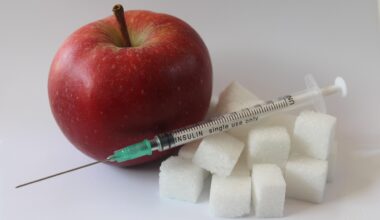How to Design a Balanced Recovery Plan for Cardiovascular Training
Recovery is crucial for cardiovascular athletes to optimize their training results after workouts. A well-structured recovery plan incorporates various methods to promote healing and reduce injury risk. This plan should address both physical and mental recovery, ensuring a holistic approach. Key factors to consider include nutrition, sleep, hydration, and active recovery techniques. Nutrition plays a vital role in replenishing glycogen stores and repairing muscle tissue. Foods rich in proteins and carbohydrates are essential post-workout. Additionally, adequate sleep is fundamental for overall recovery and performance improvement. Athletes should aim for seven to nine hours of good quality sleep each night. Hydration supports cardiovascular health and aids recovery by preventing muscle cramps and supporting metabolic functions. Active recovery techniques, such as light jogging, swimming, or stretching, can also facilitate blood flow and reduce stiffness. Finally, recovery modalities like massage or foam rolling may speed up recovery. A balanced recovery plan should integrate these elements to maintain optimal athletic performance over time.
Active Recovery Techniques
Active recovery techniques are beneficial for cardiovascular athletes as they help maintain blood circulation without placing stress on the body. This strategy allows the athlete to continue engaging in light activities even during recovery periods. Activities can include walking, cycling, or swimming at a relaxed pace. These activities facilitate muscle repair and help reduce soreness, enabling a quicker return to high-intensity workouts. Furthermore, engaging in active recovery can mitigate the psychological challenges that arise during lengthy training blocks. It allows athletes to remain connected to their sport without pushing through intensity. Stretching, yoga, and light resistance training also serve as effective forms of active recovery. These forms enhance flexibility, mobility, and blood flow, contributing to overall recovery. Athletes should listen to their bodies and adjust the intensity of these activities based on how they feel post-exercise. A successful active recovery session should leave the athlete feeling better, not fatigued. Including a variety of active recovery options in a balanced recovery plan can yield substantial benefits for cardiovascular athletes.
Nutrition is a cornerstone of a successful recovery plan for cardiovascular athletes. Proper post-exercise nutrition ensures the body has the necessary fuel to recover and adapt. After long endurance sessions, athletes should consume a meal rich in carbohydrates and proteins within an hour, ideally targeting a 3:1 ratio. Carbohydrates replenish glycogen stores depleted during the workout, while protein aids in muscle repair and growth. Incorporating sources like lean meats, dairy, fruits, and whole grains is vital. Additionally, antioxidants present in fruits and vegetables may help combat oxidative stress caused by intensive exercise. Hydration is equally essential; fluid losses can significantly impair recovery, performance, and overall well-being. Athletes should monitor their hydration status and consume electrolytes after intense workouts. It can be beneficial to take a holistic approach by including micronutrients in their diet, as they aid in various recovery processes. Supplements like omega-3 fatty acids may also help reduce inflammation and enhance recovery when dietary sources are insufficient. Understanding the importance of nutrition in a recovery plan is paramount for cardiovascular athletes.
Rest is perhaps one of the most overlooked aspects of recovery for cardiovascular athletes. Adequate rest plays a critical role in the body’s ability to repair and strengthen itself. It is during rest that the body undergoes most of its recovery processes, including muscle repair and adaptation. Therefore, it’s essential to incorporate regular rest days into an overall training schedule. These days allow the muscles time to rest, which reduces the risk of overuse injuries and burnout. Athletes often fear losing fitness during this downtime; however, research shows that strategic rest periods can lead to better performance outcomes in the long run. Additionally, scheduling deload weeks—where training intensity is significantly reduced—can help prevent overtraining. Athletes must also focus on quality over quantity when it comes to their workouts. This approach can significantly impact performance. Incorporating mindfulness and relaxation techniques such as meditation can also provide mental rest, boosting overall well-being. Balancing high-intensity training with adequate rest is crucial for cardiovascular athletes to perform optimally.
Importance of Sleep for Recovery
Sleep serves as an essential component of the recovery process, particularly for cardiovascular athletes. Quality sleep enhances physical and mental recovery, leading to improved performance. During deep sleep stages, growth hormones are released, promoting muscle repair and growth while enhancing cognitive function. Inadequate sleep can decrease training efficiency, leading to fatigue, decreased immune response, and increased risk of injuries. Therefore, athletes should prioritize sleep by establishing a consistent sleep schedule, aiming for seven to nine hours. Creating an ideal sleep environment can enhance sleep quality; this includes a dark, cool, and quiet bedroom. Additionally, practices such as limiting screen time before bed, avoiding caffeine, and practicing relaxation tactics can promote better sleep. Poor sleep quality can significantly impact overall mood and increase stress levels, which adversely affects recovery. Athletes might consider employing sleep aids, such as herbal teas, for restful nights. Tracking sleep patterns using wearable technology or apps can help athletes identify triggers for disrupted sleep. Recognizing sleep’s importance in recovery enables cardiovascular athletes to optimize their training results effectively.
Hydration plays a vital role in the recovery process, especially for cardiovascular athletes engaged in intense training. Keeping hydrated can significantly influence physical performance, muscle recovery, and overall well-being. When athletes fail to drink enough fluids, they risk dehydration, which can cause a myriad of issues, including fatigue and reduced endurance capacity. Proper hydration before, during, and after training ensures optimal cardiovascular function and minimizes the likelihood of cramps and strains. Sports drinks can replenish essential electrolytes lost during prolonged workouts, helping maintain hydration levels and improving recovery. Moreover, athletes should listen to their bodies and adapt their hydration strategies according to environmental factors such as temperature and humidity. Furthermore, tracking fluid intake can provide valuable insights into personal hydration needs. Simple methods, like checking the color of urine, can indicate hydration levels; dark urine usually suggests dehydration, while clear urine indicates proper hydration. Increasing fluid intake on recovery days is essential, as the healing process requires sufficient water. A balanced approach to hydration can boost performance and facilitate quicker recovery for cardiovascular athletes.
Utilizing Recovery Technologies
In recent years, recovery technologies have gained popularity among cardiovascular athletes. These tools and devices enhance the recovery process, providing data-driven insights that can optimize training. Technologies such as compression garments, cryotherapy, and infrared therapy have been shown to support recovery and reduce muscle soreness. Compression garments enhance blood circulation, promoting faster recovery and reducing swelling. Cryotherapy, whether performed locally or in chambers, expels lactic acid, leading to alleviated soreness and inflammation. Infrared therapy uses light to stimulate healing at a cellular level, enabling quicker recovery. Many athletes have started using wearable devices that monitor physiological metrics such as heart rate variability and sleep patterns. Analyzing these metrics can offer insights into recovery status and inform adjustments to training programs. Mobile applications provide an interactive platform for tracking nutrition, hydration, and recovery practices. Integrating these technologies offers athletes a competitive edge, enhancing their training outcomes and experiences. Ultimately, properly selected recovery technologies can become a critical part of a well-rounded recovery plan for cardiovascular athletes.
In conclusion, designing a balanced recovery plan for cardiovascular athletes requires a comprehensive approach. This plan should prioritize nutrition, hydration, sleep, active recovery, and the use of recovery technologies. Nutrition is foundational for replenishing lost energy and repairing tissues, while hydration keeps the cardiovascular system functioning optimally. Adequate sleep ensures the body has time to recuperate and enhances overall performance. Additionally, integrating active recovery techniques helps maintain fitness while minimizing injury risks. Recovery technologies offer innovative solutions to reduce soreness and improve recovery rates. Each component of the recovery plan is interconnected, emphasizing the importance of a holistic approach. Athletes must monitor their individual needs and adapt their recovery strategies accordingly to maximize performance. Moreover, recovery should not be viewed as a luxury but rather as an essential requirement for athletic success. Balancing training with effective recovery strategies allows cardiovascular athletes to push for higher levels while staying injury-free. By understanding and implementing these diverse recovery methods, athletes can ensure a sustainable athletic journey.


